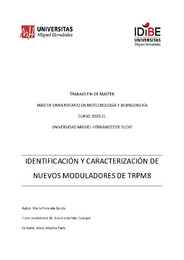Please use this identifier to cite or link to this item:
https://hdl.handle.net/11000/25461Full metadata record
| DC Field | Value | Language |
|---|---|---|
| dc.contributor.advisor | Fernández Carvajal, Asia | - |
| dc.contributor.advisor | Medina Peris, Alicia | - |
| dc.contributor.author | Foronda García, Marta | - |
| dc.contributor.other | Departamentos de la UMH::Bioquímica y Biología Molecular | es_ES |
| dc.date.accessioned | 2021-11-19T10:26:06Z | - |
| dc.date.available | 2021-11-19T10:26:06Z | - |
| dc.date.created | 2021-06-29 | - |
| dc.identifier.uri | http://hdl.handle.net/11000/25461 | - |
| dc.description.abstract | El receptor de potencial transitorio subfamilia melastatina número 8 (TRPM8) es un termocanal polimodal catiónico no selectivo permeable a calcio. Es sensible a temperaturas suaves y a compuestos refrescantes naturales y sintéticos. Se expresa en varios tejidos del cuerpo humano, desempeñando importantes funciones fisiológicas. En neuronas sensoriales primarias de la vía somatosensorial media la termotransducción del frio. Debido a la ubicuidad del canal, un mal funcionamiento del mismo puede desencadenar diversas enfermedades. Aunque se ha caracterizado un heterogéneo grupo de moduladores y muchos de ellos muestren resultados prometedores en fase preclínica, pocos llegan a fase clínica. Una de las causas de la dificultad de aplicabilidad clínica puede radicar en la falta de traslación del modelo murino, el más utilizado en ensayos in vitro, al humano. Para determinar las posibles diferencias a la respuesta de moduladores entre el canal TRPM8 de humano (hTRPM8) y de rata (rTRPM8) en este trabajo se han estudiado la eficacia, potencia, selectividad y citotoxicidad de cuatro compuestos antagonistas (β – lactamas) y dos compuestos agonistas (mentol e icilina). Para ello se han llevando a cabo ensayos fluorimétricos y de viabilidad celular. Respecto a los antagonistas, los resultados obtenidos indican que la icilina presenta mayor afinidad por el canal rTRPM8 y el mentol por hTRPM8. En cuanto a los antagonistas, los 4 compuestos presentan mayor afinidad por rTRPM8. El compuesto 3 actúa como antagonista parcial del TRPM8 y presenta una mayor diferencia entre especies, resultando 16 veces más potente para rTRPM8. A altas concentraciones, estos compuestos presentan una ligera capacidad para activar el canal TRPV1, siendo el más potente el compuesto 1. Respecto a la toxicidad de los antagonistas, el compuesto 1 no es tóxico a ninguna de las concentraciones probadas, mientras que los compuestos 2, 3 y 4 son tóxicos a todas las concentraciones utilizadas, menos el compuesto 4 a 1μM (100 % viabilidad). Pese a la similitud estructural entre rTRPM8 y hTRPM8, los resultados demuestran que existen diferencias en eficacia y potencia tanto con los agonistas mentol e icilina, como con los 4 antagonistas estudiados. Las diferencias existentes entre ambos ortólogos en cuanto a la eficacia y potencia de los moduladores estudiados, apoyan el empleo del modelo basado en hTRPM8 en estudios preclínicos. | es_ES |
| dc.description.abstract | The transient receptor potential subfamily melastatin number 8 (TRPM8) is a non-selective calcium-permeable cationic polymodal thermo-channel. It is gated by mild temperatures and cooling natural or synthetic compounds. It is expressed in different tissues of the human body, performing important physiological functions. In primary sensory neurons of the somatosensory pathway, it mediates cold thermo-transduction. Due to the ubiquity of the channel, a malfunction might trigger various diseases. Although a heterogeneous group of modulators has been characterized and many of them show promising results in the preclinical phase, just a few of them reach clinical phases. One possible reason for this failure in clinical applicability may lie in the fact that there is a lack of translation from the murine model, the one most used in in vitro tests, to the human. In order to determine possible differences in the modulators responses between human TRPM8 (hTRPM8) and rat TRPM8 (rTRPM8), efficacy, potency, selectivity and cytotoxicity of four antagonist compounds (β-lactams) and two agonist compounds (menthol and icillin) were studied in this assay. Fluorometric and cell viability tests were carried out to assess those properties. Regarding the antagonists, the obtained results indicate that icillin has a higher affinity for the rTRPM8 channel and menthol for hTRPM8. Focusing on the antagonists, the 4 tested compounds have higher affinity for rTRPM8. Compound 3 acts as a partial antagonist of TRPM8 and shows the greatest species difference in potency, being 16 times more potent for rTRPM8 than for hTRPM8. These compounds show a slight capacity to activate the TRPV1 channel at high concentrations, being compound 1 the most potent of them all. Regarding the antagonists toxicity, compound 1 is not toxic at any of the tested concentrations while compounds 2, 3 and 4 are toxic at all used concentrations but compound 4 at 1 μM (100% viability). Despite the structural similarities between rTRPM8 and hTRPM8, the obtained results show that there are differences in efficacy and potency for both the agonists menthol and icillin, and the 4 studied antagonists. The differences between the two orthologs, in terms of the efficacy and potency of the modulators studied, support the use of the hTRPM8 model in preclinical studies. | es_ES |
| dc.format | application/pdf | es_ES |
| dc.format.extent | 50 | es_ES |
| dc.language.iso | spa | es_ES |
| dc.publisher | Universidad Miguel Hernández | es_ES |
| dc.rights | info:eu-repo/semantics/openAccess | es_ES |
| dc.rights.uri | http://creativecommons.org/licenses/by-nc-nd/4.0/ | * |
| dc.subject | hTRPM8 | es_ES |
| dc.subject | rTRPM8 | es_ES |
| dc.subject | canal iónico | es_ES |
| dc.subject | fluorimetría | es_ES |
| dc.subject | modulador | es_ES |
| dc.subject.other | CDU::5 - Ciencias puras y naturales::57 - Biología | es_ES |
| dc.title | Identificación y caracterización de nuevos moduladores de TRPM8 | es_ES |
| dc.type | info:eu-repo/semantics/masterThesis | es_ES |
| dc.contributor.institute | Instituto de Investigación, Desarrollo e Innovación en Biotecnología Sanitaria de Elche | es_ES |

View/Open:
202 FORONDA GARCIA, MARTA-Memoria TFM.pdf
1,93 MB
Adobe PDF
Share:
.png)
